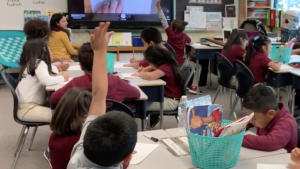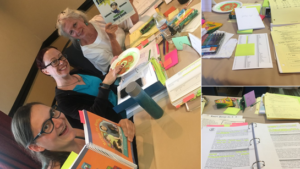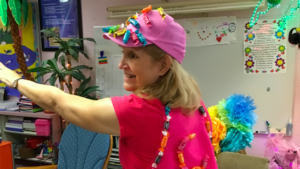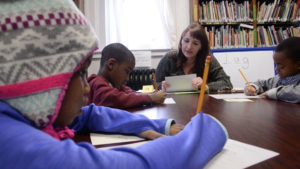From classroom instruction to intervention — teachers across the country are seeing success with IMSE’s OG. In Indiana, a veteran teacher said focusing on one letter a day is keeping students from reversing letters. A North Carolina teacher said her students never miss a beat when she purposefully misspells words. And in New Jersey, a special education teacher reports big jumps in literacy scores.
Across every success story, commonalities emerge. We’ve rounded up five key factors that supercharge success, and are sharing them here in the hopes that you can implement them at your school.
 1. IMSE’s OG Becomes Part of School Culture
1. IMSE’s OG Becomes Part of School Culture
By the end of this school year, every third grader in Bridgeton, N.J., public schools will have received OG instruction every year since Kindergarten. All K-3 teachers are trained in the literacy approach — a move district administrators say is reaping rewards.
“The biggest piece of success here is that it’s become a culture here,” said Barbara Wilchensky, director of curriculum for language arts literacy. “Everybody knows OG, everybody embraces it. Even in physical education, the P.E. teacher does teams related to red words and their sounds. There are red words posted in the hallway — even the students are taking the lead on red word drills in some classes.”
By injecting OG into both classroom lessons and other school activities, teachers lay a strong foundation that helps with long-term reading comprehension.
• Read more: Creating a School-wide IMSE OG Culture Takes Literacy to the Next Level at this New Jersey School
• Read more: Arlington, VA, Says IMSE’s OG is Integral to Helping Children with Dyslexia Read with Success
• Read more: Over 500 Loudoun Co. Teachers Ready To Tackle Dyslexia With New IMSE Training
• Read more: Students in Rural North Carolina See Major Growth in Reading Levels Thanks to New Approach
 2. IMSE’s OG is Implemented in General Education Classrooms
2. IMSE’s OG is Implemented in General Education Classrooms
Teachers at the Community Day School in Pittsburgh, Penn., believe all students can benefit from IMSE’s OG — not the just the ones who are struggling. That’s why the school invested in training for classroom, language arts and ESL teachers from grades K-8.
Students across the school now learn the OG approach to reading, writing and spelling, fostering a building-wide sense of continuity that teachers say is working wonders.
• Read more: This Pittsburgh School Says Investing in Their Teachers’ English Language Core Knowledge Makes Big Impact
• Read more: Creating a School-wide IMSE OG Culture Takes Literacy to the Next Level at this New Jersey School
• Read more: Secret To Top-Rated Colorado School’s Boost In Literacy Due To New Teaching Training Program, Officials Say
• Read more: Over 500 Loudoun Co. Teachers Ready To Tackle Dyslexia With New IMSE Training
 3. Teachers are Open to Try Something New and Willing to Commit to It
3. Teachers are Open to Try Something New and Willing to Commit to It
Pop into a classroom in Ossian, Ind., and you just might find Captain Candy — a special education teacher turned superhero who teaches “C” with a cap, cape and, of course, candy.
Veteran elementary school teacher Donna Cortright said she was first inspired to dress up after taking IMSE’s OG training several years ago. In her more than 30 years of teaching, Cortright has never found a literacy approach as effective as OG — and she says part of the success is a willingness to think outside the box.
“Orton-Gillingham lets me be creative,” she said, adding that 80 percent of her students grasped “C” after she donned her cape. “… I’ll be Captain Candy as long as it takes. And it’s a lot of fun, too.”
• Read more: Special Ed Teacher Says IMSE’s OG Training Changed Her Life
• Read more: Indiana Third-Grader Reads Nearly Four Times Faster After Teacher Uses IMSE’s Orton-Gillingham Method
• Read more: Secret To Top-Rated Colorado School’s Boost In Literacy Due To New Teaching Training Program, Officials Say
 4. School and District Support with Dedicated Leadership
4. School and District Support with Dedicated Leadership
Michigan’s new “Third Grade Guarantee” law, set to go into effect for the 2019-20 school year, stops third-graders who don’t meet grade-level reading standards from advancing to the fourth grade. Thousands of children could repeat the school year.
At The James and Grace Lee Boggs School in Detroit, Mich., administrators took a proactive approach by enrolling teachers in IMSE’s OG training. Kids now receive OG instruction during small group, whole class and differentiated instructional settings — which teachers say creates a consistent, systematic foundation that gives students a strong toolkit to ensure grade-level proficiency.
“Giving our teachers a common language, across our whole staff … that’s a huge part of IMSE’s Orton-Gillingham work that we like,” said Liz Kirk, the school’s Multi-Tiered Systems of Support coordinator.
• Read more: As Michigan Grapples With Literacy Rates, This Detroit School Tries Something New
• Read more: Orton-Gillingham and Technology Intersect at this Atlanta School
• Read more: Creating a School-wide IMSE OG Culture Takes Literacy to the Next Level at this New Jersey School
 5. Commitment to Ongoing Support
5. Commitment to Ongoing Support
In Evergreen, Colo., it wasn’t enough for Principal Peggy Miller to ensure all of her classroom teachers were trained in IMSE’s OG. The administrator was so impressed by the training’s immediate results that she also signed up art, gym and music teachers for OG courses.
Her schools, Bergen Valley and Bergen Meadows, were already two of the top-rated in the state. But as awareness around literacy rates and dyslexia rose in Colorado, Miller dove into her students’ data to see where improvements could be made. The result? “Amazing.”
Teachers who took OG training came back feeling refreshed and more knowledgeable than ever: “They said, ‘I get it now, I understand.’ So we’re going to send more teachers to the Intermediate training.”
• Read more: Secret To Top-Rated Colorado School’s Boost In Literacy Due To New Teaching Training Program, Officials Say
• Read more: IMSE Chosen As Literacy Instruction Partner For Arkansas’ New R.I.S.E. Literacy Initiative

 1. IMSE’s OG Becomes Part of School Culture
1. IMSE’s OG Becomes Part of School Culture 2. IMSE’s OG is Implemented in General Education Classrooms
2. IMSE’s OG is Implemented in General Education Classrooms 3. Teachers are Open to Try Something New and Willing to Commit to It
3. Teachers are Open to Try Something New and Willing to Commit to It 4. School and District Support with Dedicated Leadership
4. School and District Support with Dedicated Leadership 5. Commitment to Ongoing Support
5. Commitment to Ongoing Support